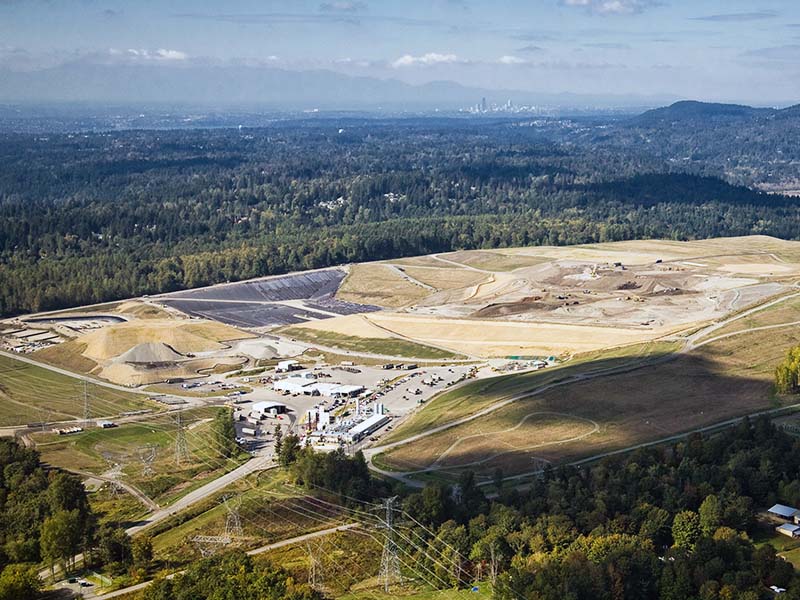
Cedar Hills Regional Landfill, King County
We're implementing a new Washington program to protect the climate by reducing methane emissions from landfills. But what is methane? Why is it leaking out of landfills? And what does that have to do with the climate? Let's dive into these questions.
What methane is
Methane is an invisible, odorless gas found throughout the air, water, and earth that surround us. It is commonly extracted from under ground to be used as the main fossil-fuel ingredient in “natural gas.” You may have heard that cow burps emit methane! It's true. Methane is produced in a variety of ways, but, in general, it's created from the breakdown of organic, once-living material, such as food waste.
Why methane leaks from landfills
Landfills are where trash ends up when it can’t be recycled. This trash often includes food scraps, yard waste, and other organic matter. When this organic matter is buried in a landfill, it breaks down slowly, releasing methane. Because methane is a gas, it can rise to the top of the landfill and escape into the atmosphere.
How methane affects the climate
Cedar Hills Regional Landfill, King County
Methane is a greenhouse gas, often called GHG, like carbon dioxide, but more than 80 times more powerful in the first 20 years after it's released into the atmosphere. You can imagine GHGs as blankets that surround the Earth. The more blankets that cover the planet, the more heat that's trapped, and the warmer the planet becomes. The Intergovernmental Panel on Climate Change (IPCC), the leading global voice on climate science, estimates that the planet will warm by between 1.4°C (2.5°F) and 4.4°C (7.9°F) by the end of this century, depending in part on how quickly and effectively GHG emissions are reduced.
Methane is responsible for more than 25% of the warming experienced today. Methane emitted from landfills in Washington accounted for 1.5 million metric tons of carbon-dioxide-equivalent GHG in 2018, according to our recent greenhouse gas inventory report. This is why reducing methane emissions from landfills is important, helping to keep the climate safer and healthier for Washington and the world.
The IPCC asked governments to reduce methane emissions by one-third by 2030 to limit the rise in average global temperature to 1.5°C (2.7°F).
How Washington is addressing the methane problem
In December 2022, we announced rulemaking on landfill methane emissions (Chapter 173-408 WAC). This rule, which will be drafted for proposal by late 2023, will require certain landfills to control their methane emissions, either by burning their landfill gas or by converting it into an energy source.
The rulemaking aligns Washington with similar methane rules for landfills in California and Oregon and will help us meet the state’s goal of reducing greenhouse gas emissions by 95% by 2050. It is one effort among many in Washington’s comprehensive strategy to fight climate change. Other programs to control emissions include:
- Cap-and-invest program
- Clean Energy Transformation Act
- Clean Fuel Standard
- Zero-emissions vehicle standard
- Hydroflurocarbon transition
Learn more
Stay up to date on our work to protect the climate by reducing methane emissions from landfills. In future blogs, we’ll be exploring topics such as the methods and technology available to help. If you want to learn more and be notified of opportunities to provide input, please subscribe to our email list.
You can read more about this work in our news release. If you have further questions, you can also reach out to our team using the contact information below.
Bill Flagg
Rulemaking Lead
bill.flagg@ecy.wa.gov
564-669-1385


